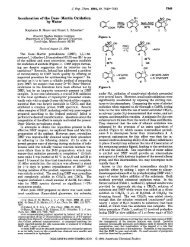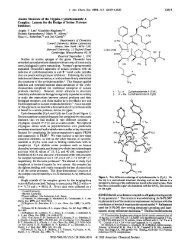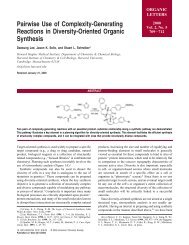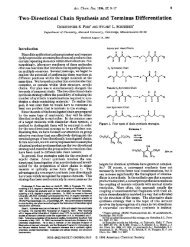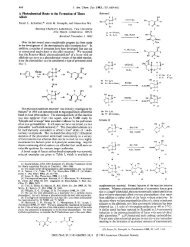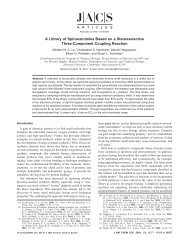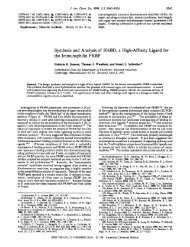J. Am. Chem. Soc. 1990, 112, 9657 - Broad Institute
J. Am. Chem. Soc. 1990, 112, 9657 - Broad Institute
J. Am. Chem. Soc. 1990, 112, 9657 - Broad Institute
Create successful ePaper yourself
Turn your PDF publications into a flip-book with our unique Google optimized e-Paper software.
9658 J. <strong>Am</strong>. <strong>Chem</strong>. <strong>Soc</strong>., Vol. <strong>112</strong>, No. 26, <strong>1990</strong> Communications to the Editor<br />
Scheme 11"<br />
Scheme 111'<br />
N,<br />
f4<br />
8-<br />
AcHN<br />
OAC 10 R=Bn<br />
(-1 ' 1 mixture of anomen) 11 =H 2'<br />
'(a) TFA-MeOH (l:3), reflux 2.5 days; TFA-THF (1:lOO) reflux<br />
IO h; H2S04-acetone (65%); (b) DIBAL-H (5 equiv), CH2C12; (c)<br />
BzCl (5 equiv) (34%, two steps); (d) Tf20 (2 equiv), Py (3 equiv),<br />
CH2CI2, 1 h, room temperature; (e) nBu,NN, (3 equiv), PhH, 15 min,<br />
room temperature (8 I%, two steps); (f) <strong>Am</strong>berlyst-15, MeOH, reflux,<br />
9 h; (g) NaOMe, MeOH, 3 h; Ac20, Py, DMAP, 12 h (83%, overall);<br />
(h) bis-TMS-cytosine (3 equiv), TMSOTf (3.3 equiv), PhN02, 3.5 h,<br />
127 "C (76%); (i) Ac20, Py, DMAP (96%); (j) DDQ (5 equiv), CH2-<br />
CI,-H,O (IO:])(74%).<br />
Terminus differentiation of the C2-symmetric chain was<br />
achieved at this stage by a monofunctionalization of the two<br />
homotopic ester groups of 2. The alcohol 3 was prepared efficiently<br />
by reduction with DIBAL-H added slowly at -78 OC. The<br />
undecose chain was constructed sequentially in two directions.<br />
Swern oxidation14 of 3 followed by Tebbe olefinationis established<br />
the terminal vinyl group, and the a&unsaturated ester moiety<br />
was introduced by a reduction, oxidation, and Homer-Emmons<br />
olefination sequence. Desilylation and ketalization furnished 4.<br />
Catalytic osmylation of 4 in the presence of a chiral amine catalyst,<br />
dihydroquinine p-chlorobenzoate,I6 afforded the tetraol 5 with<br />
good diastereoselectivity. In 11 steps, all performed on a multigram<br />
scale, the undecose chain was constructed with the necessary<br />
oxidation level and stereochemistry at each carbon.<br />
The diastereomerically pure lactone 6 was prepared from 5 by<br />
deketalization and lactonization followed by selective ketalization<br />
(Scheme 11). Reduction of 6 with DIBAL-H and selective<br />
benzoylation" of the crude lactol afforded the pure alcohol 7 after<br />
purification by preparative HPLC. With the C4 hydroxyl group<br />
differentiated, a nitrogen substituent was introduced by formation<br />
of the triflate and displacement with tetrabutylammonium azidel8<br />
to afford the azide 8,19<br />
The cytosyl group was introduced by the silyl Hilbert-Johnson<br />
reaction,20 which has been studied extensively by Vorbruggen.21<br />
Initial failures led to model studies, which identified several crucial<br />
elements necessary for success with this reaction. Acetyl protecting<br />
groups instead of benzoyl groups about the pyranose ring resulted<br />
in increased yields. Thus, the derivative 9 was prepared as a<br />
mixture of anomers by deketalization and debenzoylation followed<br />
by peracetylation. Reaction in nitrobenzene was significantly<br />
faster than in acetonitrile, a solvent typically used with<br />
TMSOTf-catalyzed reactions.22 Treatment of 9 with bis(tri-<br />
(14) Omura, K.; Swern, D. Tetrahedron 1978, 34, 1651.<br />
(15) Tebbe, F. N.; Parshall, G. W.; Rcddy, G. S. J. <strong>Am</strong>. <strong>Chem</strong>. <strong>Soc</strong>. 1987,<br />
100, 361 I .<br />
(16) Jacobsen, E. N.; Mark6, I.; Mungall, W. S.; Schrtider, G.; Sharpless,<br />
K. B. J. <strong>Am</strong>. <strong>Chem</strong>. SOC. 1988, 110, 1968.<br />
(17) See: (a) Reist, E. J.; Spencer, R. R.; Calkins, D. F.; Baker, B. R.;<br />
Goodman, L. J. Org. <strong>Chem</strong>. 1965, 30, 2312. (b) Danishefsky, S.; Maring,<br />
C. J. J. <strong>Am</strong>. <strong>Chem</strong>. <strong>Soc</strong>. 1989, 111, 2193; (c) 1985, 107, 7762.<br />
(18) See: Danishefsky, S. J.; DeNinno, M. P.; Chen, S.-h. J. <strong>Am</strong>. <strong>Chem</strong>.<br />
SOC. 1988, 110, 3929.<br />
(19) The structure was confirmed by conversion to methyl peracetyl-ahikosaminide<br />
by glycosidation, reduction, deprotection, and peracetylation.<br />
The 'H NMR spectrum matched the one reported by Maring (Maring, C.<br />
J. Ph.D. Thesis, Yale University, 1986).<br />
(20) Iwai, I.; Nishimura. T.; Shimizu, 6. Synth. Proced. Nucleic Acid<br />
<strong>Chem</strong>. 1968, I, 388.<br />
(21) Niedballa, U.; Vorbriiggen, H. Angew. <strong>Chem</strong>., Ini. Ed. Engl. 1970,<br />
9, 461.<br />
(22) Vorbriiggen, H.; Krolikiewicz, K.; Bennua, B. <strong>Chem</strong>. Ber. 1981, 114,<br />
1234.<br />
+<br />
w,,*"p<br />
11 6Ac ;:Rzy2b<br />
14 + C YN y-yfi + d hlklzlmycln<br />
HO<br />
: Ns<br />
&I 15<br />
tmwcti<br />
(a) Tf20, tol-CH2CI2, 2,6-tBu2-4-MePy (38%. 41% SM); (b)<br />
DDQ. CH2C12, 43 h, 58 O C (52%, 17% SM); (c) nBu4NOH, MeOH,<br />
reflux, 2 h: (d) H2 (I atm). Lindlar cat., H20, 30 min (quant, two<br />
steps).<br />
methylsilyl)cytosine and TMSOTf in nitrobenzene (127 "C)<br />
yielded the nucleoside in 76% yield. Acetylation then furnished<br />
10. The site-selective unmasking of the C6 hydroxyl group was<br />
achieved by oxidative debenzylation with DDQ, which is commonly<br />
used to remove p-methoxybenzyl ethers.23 Treatment of<br />
10 with exw DDQ in dichloromethane-water selectively afforded<br />
the alcohol 11 with high selectivity. The slower rate of oxidative<br />
debenzylation at C7 may reflect in part the decreased electron<br />
density at this site relative to C6.<br />
Glycosidation was achieved by applying the sulfoxide activation<br />
method of Kahr~e.~~ Addition of Tf20 to the sulfoxide 122s<br />
followed by the alcohol 11 yielded the glycoside 13 (Scheme 111).<br />
Conversion of 13 to hikizimycin required debenzylation of the C7<br />
hydroxyl group, deacylation of the undecose and hexose sugar<br />
moieties as well as the cytosine residue, and reduction of the two<br />
azido groups. Debenzylation under various reducing conditions<br />
was unsuccessful because of the sensitivity of the cytosyl group.<br />
The oxidative debenzylation with DDQ was again studied. The<br />
slow reaction led to decomposition of 13 resulting from acidic<br />
products formed from hydrolysis of DDQ. It was subsequently<br />
found that debenzylation did not require the presence of added<br />
water;26 thus, treatment of 13 with excess DDQ in dry dichloromethane<br />
at 58 OC for 2 days resulted in clean debenzylation<br />
to afford the desired alcohol 14. Complete deacylation with<br />
refluxing methanolic tetrabutylammonium hydroxide2' readily<br />
afforded the poly01 15, and hydrogenation with Lindlar catalyst2*<br />
reduced the azido groups to yield hikizimycin in quantitative yield.<br />
The synthetic substance was identical with natural hikizimycin<br />
in all respects.<br />
The studies reported herein serve as another illustration of the<br />
potential of the two-directional chain synthesis strategy and<br />
confirm the proposed structure of the highly unusual anthelmintic<br />
agent hikizimycin.<br />
Acknowledgment. We thank the NIGMS (GM-38627) and<br />
Pfizer for their support of this research and Dr. R. Nagarajan<br />
(23) Oikawa, Y.; Yoshioka, T.; Yonemitsu, 0. Tetrahedron Lett. 1982,23,<br />
885.<br />
(24) Kahne, D.; Walker, S.; Cheng, Y.; Van Engen, D. J. <strong>Am</strong>. <strong>Chem</strong>. <strong>Soc</strong>.<br />
1989, 111, 6881.<br />
(25) Details of the synthesis of the kanosamine derivative 12 will be provided<br />
in a full account of this research.<br />
(26) Oxidative dehydrogenation of aromatic compounds at the benzylic<br />
position under anhydrous conditions has been reported: Naidu, M. V.; Rao,<br />
G. S. K. Synthesis 1979, 144.<br />
(27) (a) Griffin, B. E.; Jarman, M.; Reese, C. B. Terrahedron 1968, 24.<br />
639. (b) van Boeckel, C. A. A.; van Boom, J. H. Teirahedron Leii. 1979,<br />
3561.<br />
(28) Corey, E. J.; Nicolaou, K. C.; Balanson, R. D.; Machida, Y. Synthesis<br />
1975, 590.



